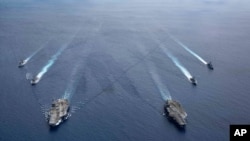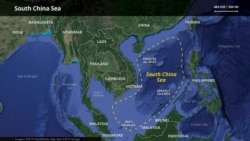China reacted strongly Tuesday to the Trump administration’s rejection of China’s broad territorial claims in the South China Sea, calling Washington “a troublemaker and a disruptor of regional stability.”
Years after China started building military bases on remote reefs and islands deep in international waters, the Trump administration Monday hardened Washington’s official stance on the matter, rejecting China’s claims as “completely unlawful.”
The United States itself has no territorial claims in the South China Sea and has long maintained it is mainly interested in keeping the waters safe for international shipping. U.S. officials have said countries with competing claims should peacefully resolve any territorial disputes. In 2016, an international arbitration court ruled China’s maritime claims had no basis in law.
After Monday’s U.S. statement, Indonesia and the Philippines joined in, calling on China to abide by the international arbitration court ruling. Malaysia’s foreign ministry declined to comment.
In Beijing, officials rejected the Trump administration’s statement, claiming it had no say in the matter.
“The United States is not a country involved in the regional territorial disputes, but it continues to interfere and keeps flexing military muscles in the region,” read a statement from the Chinese Embassy in Washington. “It’s stirring up tension and inciting confrontation in the region.”
China vies with Brunei, Malaysia, Taiwan, Vietnam, and the Philippines over parts of the 3.5 million-square-kilometer South China Sea.
Separate naval drills
China uses a “nine-dash line,” sourcing it to maritime records from dynastic times, to claim about 90% of the waterway that others in the region value for its fisheries and undersea fossil fuel reserves. The nine dashes also cut into some nations’ Exclusive Economic Zone (EEZ).
Last week, two U.S. aircraft carriers — the Ronald Reagan and the Nimitz — drilled together in the South China Sea in a show of force.
The two carriers were deployed to the South China Sea to conduct tactical exercises designed to maximize air defense capabilities “in support of a free and open Indo-Pacific”, according to a statement by the U.S. Navy.
Rodger Baker, senior vice president of Strategic Analysis at geopolitical intelligence company Stratfor, told VOA the U.S. wanted to assure its allies the U.S. remains committed to the region.
“The U.S. is trying to reiterate its position that this is open water that everyone can use, and the U.S. will provide security for it," Baker said. “Based on this idea, regional countries can make their own decisions about China. The United States will be there, and these countries can claim their own sovereignty.”
Baker added that the two-carrier exercise in the South China Sea foreshadows that U.S. military operations in the Western Pacific will increase down the road.
China announced it would also conduct military exercises at the same time U.S. carriers drilled in the region. The Chinese military said it held military drills in the contested Paracel Islands, known as the Xisha Islands in Chinese, from July 1 to July 5.
Observers are concerned the muscle flexing from both sides is threatening to tilt the volatile maritime region ever closer to military conflict.
“Both are really, really cautious to avoid slide into a hot war, but accidents can happen,” Baker said.
At a recent hearing at the U.S.-China Economic and Security Review Committee, former Under Secretary of Defense for Policy Michele Flournoy told lawmakers she’s concerned that China would be more risk-prone as its Navy continues to grow.
“I think China views the United States in a period of inevitable decline and withdrawal from the world,” Flournoy said. “I think they risk underestimating the resolve, which can be provoked by the crisis.”
U.S. Assistant Secretary of State David Stilwell said Tuesday the U.S. could respond with sanctions against Chinese officials and state-owned enterprises for their involvement of coercive actions in the South China Sea.
"Nothing is off the table,” said Stilwell when asked if sanctions were a possible U.S. response to Chinese actions during a webinar hosted by Center for Strategic and International Studies. “There is room for that. This is a language the Chinese understand — demonstrative and tangible action.”
Earlier this month, China said it would resume negotiations with Southeast Asian leaders on a code of conduct that has been pending since 2002 to avoid mishaps and resolve any accidents in South China Sea.
Stilwell urges “greater transparency” in the process, citing “clear red flags about Beijing’s intentions” behind closed doors, as China is said to push claimants in the Southeast Asian region “to accept limits on core matters of national interest."
VOA's Nike Ching, Si Yang, Adrianna Zhang contributed to this story.









